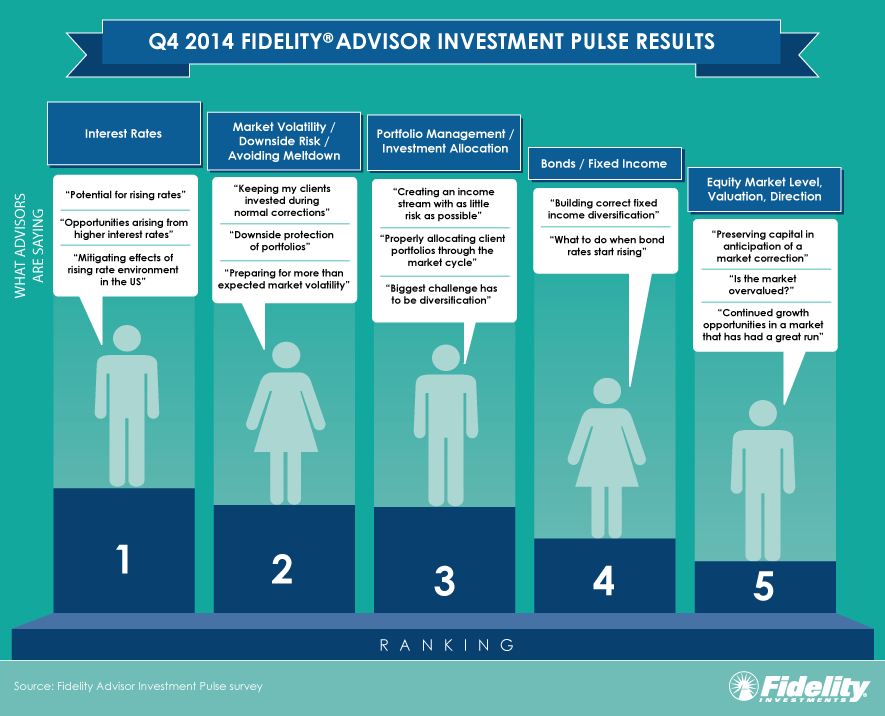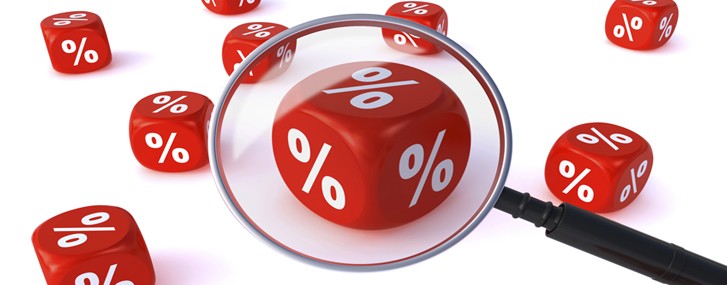Rate outlook Invest for uncertainty Fidelity Investments
Post on: 8 Июнь, 2015 No Comment

Your e-mail has been sent.
Interest rates have been low for more than five years. The economy seems to be gaining momentum, and inflation is edging up. The Fed is buying fewer long-term bonds every month and eyeing a possible short-term rate hike next year. To many people, the conclusion is obvious: Interest rates are sure to rise a lot, and soon.
Not so fast, say Fidelity’s Julian Potenza, fixed income asset allocation analyst, and George Fischer, managing director of research. “We think many investors are being overconfident about their ability to predict rate moves,” says Fischer. “No one knows the future.”
That perspective has important investment implications. Potenza and Fischer argue that the inherent uncertainty of markets calls for maintaining a strategic position in bonds, with a mix that suits your specific situation and reflects the reasons you hold fixed income. “If you knew the future, you could time your investment moves perfectly, selling out of stocks before downturns, or bailing on bonds before rates rise,” says Potenza. “But trying to time any market is extremely difficult. No one has that type of foresight. In a portfolio context, bonds may help to protect you from things you don’t know.”
The problem with trusting your gut
Fischer acknowledges that rates could move significantly higher. But he points out that forces ranging from a stumble in the U.S. economy to conflict in the Middle East could slow or even reverse any rise in rates. Moreover, he points out that investors’ very confidence that rates are about to jump could make a rapid increase less likely. “The more certain and confident people are about the future, the more the future they expect is likely to be priced into the market—and the more the market’s likely to move in a way that frustrates them,” he says. “It’s paradoxical: The more certain you feel that you know the direction of interest rates, the less confident you should be that you’re right.”
Recent history suggests maintaining a healthy degree of skepticism toward the conventional wisdom on rates. Multiple times over the last four years, much of the market has been convinced rates were about to rise, and every time bonds’ actual performance has confounded their expectations. A number of famous investors have made headlines by making big, unsuccessful bets on rising rates—but it’s not just big guns who have misfired. Consider the following chart, which plots rate forecasters’ projections against actual interest rates at various points over the last 15 years. As you can see, professional rate prognosticators have consistently anticipated higher rates, and have consistently been wrong.
Forecasting rate changes can be hard.
Source: Rolling 5-Quarter Median Forecasts of 10-Year Note Yields in the Philadelphia Fed’s Quarterly Survey of Professional Forecasters: 2000-2014.
The point isn’t that rates won’t rise—it’s that no one knows when they’ll increase or by how much. So rather than try to guess at an unknowable future, bond investors should consider the range of plausible scenarios and the reasons they hold bonds, and invest accordingly.
Investing based on possibilities, not certainty
Potenza and Fischer present three potential scenarios for future rate moves:
Scenario #1: Rates stay below “normal” levels but bump up slowly and unevenly.
Fischer and Potenza think this appears to be the most likely outcome for the bond market over the next two to three years. For rates to rise a great deal, the economy almost certainly would have to strengthen meaningfully—and while the economy continues to heal, it remains shaky in important ways.
During the second quarter, the economy’s growth rate bounced back from its winter weakness, and the job market improved considerably. But if you look at the first half of the year overall, GDP growth remains in the 2.0% to 2.5% range—similar to the last several years. Meanwhile, total employment has only recently surpassed its precrisis peak despite continued population growth and years of extraordinary monetary stimulus. At the same time, sluggish wage growth and low workforce participation suggest continued slack in the economy, which is likely to restrain inflation and interest rates.
The economy also continues to work its way through the deleveraging cycle that has held back growth since 2008. While debt levels have come down from their peaks, they remain high by historical standards, making a credit-driven boom unlikely.
Leverage remains high—U.S. debt outstanding by sector
Source: Federal Reserve and Fidelity calculations, as of March 31, 2014.
Furthermore, the U.S. economy continues to be interest-rate sensitive, so any increase in rates would likely prove self-limiting. Higher rates would weigh on economic growth, which in turn would probably slow or even prevent further rate increases—the softening of housing market data following last year’s rate rise is a clear example. And a slew of other factors, from the aging population to low global inflation to Fed caution, also support the thesis of a very gradually healing economy and a slow, bumpy rise in interest rates.

The market appears to have priced in a gradual rate increase, say Potenza and Fischer. In this scenario, bond prices should decrease modestly, with longer-term bonds’ prices falling more than the prices on shorter-term bonds. But from a total return perspective, the higher yields on longer-term bonds should help to offset those larger price declines. The result: Bonds across the yield curve could be expected to produce roughly flat total returns while providing important tail risk protection during periods of market volatility.
Scenario #2: Rates jump.
The bond bears could be right: In one possible scenario, interest rates could leap upward and result in substantial losses for bonds, especially on the long end. How would you know whether that was coming to fruition? A sharp rise in rates might result from a surge in economic growth or a rapid increase in inflation. The former could occur if capital investment increases dramatically, while the latter could be driven by higher wages if the labor market tightens. In either case, the Fed may raise short-term rates sooner than expected.
While Potenza and Fischer say that that future seems unlikely given all the factors holding back economic growth and inflation, they don’t rule it out. If rates spiked, bond prices would fall substantially and investors’ total returns would suffer, at least in the short term. The impact wouldn’t be entirely negative for investors with long time horizons, however, because they’d be able to reinvest the principal from maturing bonds at higher yields. At the same time, an accelerating economy might make a positive backdrop for corporate earnings, which in turn could help the performance of stocks. So a diversified portfolio might benefit from strong stock returns even as bond prices fall.
Scenario #3: Rates stay low or fall.
The past five years show time and again that a recovering economy does not guarantee that interest rates must rise. Consider the first half of this year. Entering 2014, most investors expected bond yields to rise. But Potenza and Fischer warned that expectations had gotten ahead of themselves and that rates were likely to remain low or even fall.
Yields didn’t rise, of course: The yield on the 10-year Treasury bond began the year at about 3.0%, and sat at about 2.5% as of July 24.
Rates could stay put or fall for a number of reasons. A geopolitical crisis could shake the global economy—indeed, the likelihood of such an event occurring seems to have increased in recent months. The U.S. economy could slow, perhaps as the result of weakness in Europe or Asia. The Fed could decide that the economy needs additional stimulus, leading it to retreat or reverse course on its plan to reduce its bond purchases.
The upshot: Rates could fall, perhaps significantly. And in this scenario, bonds are likely to be one of very few asset classes that perform well.
Implications for investors
When considering how to invest your fixed income portfolio, start with the reason you hold bonds in the first place. The objectives for your bond allocation will largely determine the mix of security types and durations that are right for you.














